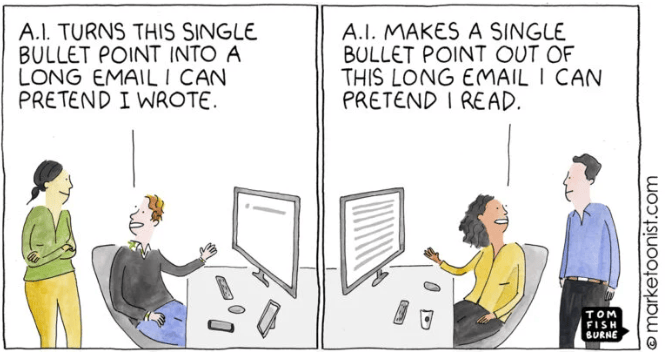- AI for Ecommerce and Amazon Sellers
- Posts
- Guide: Humanizing AI-Generated Content
Guide: Humanizing AI-Generated Content
Plus new from Grok and ElevelLabs

From Our Sponsor:
Find your customers on Roku this Black Friday
As with any digital ad campaign, the important thing is to reach streaming audiences who will convert. To that end, Roku’s self-service Ads Manager stands ready with powerful segmentation and targeting options. After all, you know your customers, and we know our streaming audience.
Worried it’s too late to spin up new Black Friday creative? With Roku Ads Manager, you can easily import and augment existing creative assets from your social channels. We also have AI-assisted upscaling, so every ad is primed for CTV.
Once you’ve done this, then you can easily set up A/B tests to flight different creative variants and Black Friday offers. If you’re a Shopify brand, you can even run shoppable ads directly on-screen so viewers can purchase with just a click of their Roku remote.
Bonus: we’re gifting you $5K in ad credits when you spend your first $5K on Roku Ads Manager. Just sign up and use code GET5K. Terms apply.
Guide: Humanizing AI-Generated Content

Understanding the "AI Slop" Problem
One of the biggest challenges with AI-generated content is that it often sounds distinctly artificial—what many people call "AI slop." This includes overly complex sentence structures, unnecessary jargon, predictable transitions, and a generic tone that screams "written by a machine." While AI is incredibly powerful for generating ideas and first drafts, the default output often needs significant refinement to sound genuinely human.
The solution isn't to avoid AI entirely, but rather to train it to write in a more natural, direct style from the beginning, then apply systematic editing techniques to eliminate the telltale signs of artificial generation. This approach lets you keep the efficiency benefits of AI while producing content that reads as genuinely human.
Why Default AI Writing Sounds Artificial
AI models are trained on vast amounts of text from the internet, including formal academic writing, technical documentation, and marketing copy. This training creates tendencies toward:
Unnecessarily complex vocabulary when simple words would be clearer
Overly formal transitions between ideas
Generic metaphors and clichés that add no real value
Passive voice constructions that distance the reader
Hedge words that weaken statements unnecessarily
Understanding these patterns helps you both prevent them and identify them for removal.

Source: Marketoonist.com
The Complete Humanization Framework
Method 1: The Comprehensive Humanization Prompt
Use this detailed prompt when you want maximum control over style and tone:
WRITING STYLE GUIDELINES (apply to all content):
Core Principles:
- Write in clear, simple language that anyone can understand
- Be concise, practical, and informative
- Use short sentences that are easy to follow
- Choose active voice over passive voice
- Focus on actionable insights with concrete examples
- Address readers directly using "you" and "your"
- Use bullet points only when they improve readability
Strictly Avoid:
- Em dashes (—) - use periods or commas instead
- Semicolons in any context
- Markdown formatting, asterisks, hashtags, or emojis
- Clichés, unnecessary metaphors, and exaggerated claims
- Transition phrases like "in conclusion," "moreover," "however" at sentence beginnings
- Filler adjectives and adverbs that add no meaning
Banned Words and Phrases:
Remove these entirely: can, may, just, that, very, really, literally, actually, certainly, probably, basically, could, maybe, delve, embark, enlightening, esteemed, shed light, craft/crafting, imagine, realm, game-changer, unlock, discover, skyrocket, abyss, not alone, in a world where, revolutionize, disruptive, utilize/using, dive deep, tapestry, illuminate, unveil, pivotal, intricate, elucidate, hence, furthermore, however, harness, exciting, groundbreaking, cutting-edge, remarkable, remains to be seen, glimpse into, navigating, landscape, stark, testament, in summary, in conclusion, moreover, boost, skyrocketing, opened up, powerful, inquiries, ever-evolving
Output Requirements:
- Plain text only (no special formatting)
- No disclaimers or explanatory notes
- Before responding, check for and remove any em dashes
TASK: [Your specific request or paste content to rewrite]Method 2: Setting Default Style Preferences
For ongoing use, save this shorter version in your ChatGPT custom instructions:
Write clearly and directly. Use short sentences and active voice. Give practical, actionable advice. Address the reader as "you." Use bullets only when helpful.
Avoid: em dashes, semicolons, markdown, asterisks, hashtags, emojis, clichés, corporate buzzwords, unnecessary transitions ("in conclusion," etc.), and filler words like: can, may, just, that, very, really, literally, actually, probably, basically, maybe, delve, embark, shed light, imagine, realm, game-changer, unlock, discover, disruptive, utilize, dive deep, illuminate, unveil, pivotal, intricate, groundbreaking, cutting-edge, remarkable, navigating, landscape, testament, boost, skyrocketing, inquiries, ever-evolving.
Respond in plain text only. Remove any em dashes before sending.How to Apply the Humanization Process
Option 1: Generate New Content with Human Style
Start a new ChatGPT conversation
Paste the comprehensive humanization prompt
Add your specific content request (e.g., "Write a LinkedIn post about remote work productivity for managers. Include 3 practical tips and one call-to-action.")
Review the output using the quality checklist below
Option 2: Humanize Existing AI Content
Start a new ChatGPT conversation
Paste the comprehensive humanization prompt
Add this instruction: "Rewrite the following content to match this style. Keep all facts accurate, remove any hype or fluff, and make it more concise. Provide 2 different versions."
Paste your existing content
Choose the better version and apply final edits if needed
Option 3: Set as Your Default Style
Access ChatGPT settings (click your profile, then "Customize ChatGPT" or "Custom Instructions")
Find the field about how ChatGPT should respond
Paste the shorter default style version
Test with a new conversation to ensure it's working
Adjust as needed based on your specific preferences
Adapting for Different Content Types
For Business Documents
Keep the clarity guidelines but allow numbered lists for complex processes
Include: "Use precise terminology and include citations when I provide sources"
Allow slightly more formal tone while maintaining directness
For Creative Content
Relax restrictions on metaphors if they serve a specific purpose
Allow more varied sentence lengths for rhythm
Keep the ban on clichés but permit original creative language
For Technical Writing
Maintain precision requirements
Allow necessary jargon but define terms for broader audiences
Focus on logical flow and clear explanations
Quick Revision Templates
Use these follow-up prompts to fine-tune your content:
Make it More Concise: "Reduce this by 20% while keeping all key facts and the call-to-action. Follow the same style rules."
Add Supporting Details: "Add one specific example or relevant data point to support the main claim. No hype or exaggeration."
Adjust Tone: "Make this sound more conversational while keeping it professional. Same banned words and style rules apply."
Final Polish: "Check this for any remaining filler words, em dashes, or overly complex sentences. Provide the cleaned-up version."
Troubleshooting Common Issues
Still Seeing AI Markers?
Problem: Em dashes, markdown, or banned phrases still appear Solution: Add this to your request: "Before sending your response, scan for and remove any em dashes, markdown formatting, or words from the banned list. Send only the corrected plain-text version."
Content Sounds Too Robotic?
Problem: Following rules too strictly makes writing feel mechanical Solution: Ask for: "Relax the tone by 10%. Add one conversational element while keeping all the banned words and formatting restrictions."
Too Brief or Lacks Substance?
Problem: Eliminating filler words makes content too short Solution: Request: "Expand this by 20% using a concrete example and a stronger call-to-action. No filler words or banned phrases."
Inconsistent Results?
Problem: ChatGPT doesn't consistently follow the style guidelines Solution: Save the guidelines in Custom Instructions and start each relevant conversation with: "Follow my custom writing style instructions for this entire conversation."
Do You Love The AI For Ecommerce Sellers Newsletter?
You can help us!
Spread the word to your colleagues or friends who you think would benefit from our weekly insights 🙂 Simply forward this issue.
In addition, we are open to sponsorships. We have more than 40,000 subscribers with 75% of our readers based in the US. To get our rate card and more info, email us at [email protected]
The Quick Read:
JSON prompting turns AI requests into structured templates, giving marketers more consistent, reliable outputs for ads, posts, and copy without needing coding skills.
A live benchmark shows LLMs struggle badly at identifying fonts from dafont.com, proving AI still stumbles on some “simple” human tasks.
Pinterest hit 578M users and $998M revenue, but growth flatlined in the US and dipped in Europe, raising questions about its ceiling despite strong Gen Z adoption.
You heard it right, Grok 4 is now free for all users worldwide!
ElevenLabs expands into AI-generated music with licensing deals from Merlin and Kobalt, aiming to avoid lawsuits that hit rivals Suno and Udio.
Study of 17M citations shows AI assistants prefer fresher content than Google SERPs, with ChatGPT leading in citing newer pages.
Moz’s Andy Chadwick shares a 6-step framework to blend AI speed with human voice, showing content still matters for authority, links, and brand building.
GPT-5 isn’t the revolution some hoped, stronger but colder. Analysts argue AI is evolving like any tech, not racing toward AGI just yet.
House chores… What are those? Figure robot unveils a new humanoid robot.
Google’s Gemini will now “remember” your past chats by default to personalize responses, but you can toggle it off or use privacy-friendly temporary chats.
The Tools List:
🚩 Shot Solve - Instantly solve your problem with GPT-4 vision.
🤑 Openmart - Get highly targeted local business leads using AI.
🎨 Dewstack AI: Effortlessly craft and manage AI-powered docs that elevate your content and empower your users with instant answers.
🖊️ Trellus - AI sales coach on each and every call.
🌐 Globe Explorer - Visual-hierarchical search on any topic you want.
🖊️ Scribe by Appblit - Readable transcripts with automated sections and headings.
About The Writer:

Jo Lambadjieva is an entrepreneur and AI expert in the e-commerce industry. She is the founder and CEO of Amazing Wave, an agency specializing in AI-driven solutions for e-commerce businesses. With over 13 years of experience in digital marketing, agency work, and e-commerce, Joanna has established herself as a thought leader in integrating AI technologies for business growth.
For Team and Agency AI training book an intro call here.



